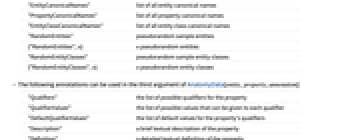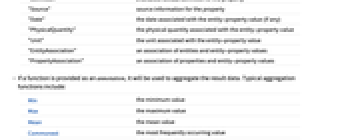AnatomyData[entity,property]
gives the value of the specified property for the anatomical structure entity.
AnatomyData[{entity1,entity2,…},property]
gives a list of property values for the specified anatomical structure entities.
AnatomyData[entity,property,annotation]
gives the specified annotation associated with the given property.


AnatomyData
AnatomyData[entity,property]
gives the value of the specified property for the anatomical structure entity.
AnatomyData[{entity1,entity2,…},property]
gives a list of property values for the specified anatomical structure entities.
AnatomyData[entity,property,annotation]
gives the specified annotation associated with the given property.
Details












- AnatomyData[] gives a list of all anatomical structure entities.
- AnatomyData["Properties"] gives a list of available properties.
- The specified entity in AnatomyData can be an Entity, EntityClass, entity canonical name, or list thereof.
- The specified property can be an EntityProperty, EntityPropertyClass, property canonical name, or list of properties.
- Properties that do not apply or are not known in a particular case are indicated by Missing[…].
- Properties include:
-
"AdjacentJointCount" adjacent joint count "AdjacentJoints" adjacent joints "AdjacentStructures" adjacent structures "AfferentVessel" afferent vessel "AlternateNames" alternate names "AnatomicalGroup" anatomical group "AnatomicalRegion" anatomical region "AnatomicalSpace" anatomical space "ArterialSupply" arterial supply "ArticulatingBones" articulating bones "AttachedMuscleCount" attached muscle count "AttachedMuscles" attached muscles "AttachedStructure" attached structure "BilateralComponents" bilateral components "BodyLocationImage" body location image "BoneArticulation" bone articulation "BoneArticulationCount" bone articulation count "Branches" branches "CellSurfaceSpecialization" cell surface specialization "ConstitutionalParts" constitutional parts "Contents" contents "ContinuationBranches" continuation branches "ContinuousStructures" continuous structures "Definition" definition "Density" density "Depth" depth "DerivedStructures" derived structures "DevelopmentalOrigin" developmental origin "Diameter" diameter "DistallyContinuousStructure" distally continuous structure "EfferentVessel" efferent vessel "EnclosingCuboid" enclosing cuboid "EnclosingSphere" enclosing sphere "EnclosingSphereDiameter" diameter of enclosing sphere "EnclosingSphereRadius" radius of enclosing sphere "ExternalStructure" external structure "FascicularArchitecture" fascicular architecture "Function" function "GermOrigin" germ origin "Graphics3D" 3D graphic "Graphics3DPrimitives" 3D graphic primitives "IncludedArteries" arteries "IncludedBones" bones "IncludedCartilages" cartilages "IncludedJoints" joints "IncludedLigaments" ligaments "IncludedLymphaticVessels" lymphatic vessels "IncludedMuscles" muscles "IncludedNerves" nerves "IncludedOrgans" organs "IncludedTendons" tendons "IncludedVeins" veins "Innervations" innervations "InputPathway" input pathway "InsertedMuscleCount" inserted muscle count "InsertedMuscles" inserted muscles "InternalStructure" internal structure "LatinName" Latin name "Length" length "LymphaticDrainage" lymphatic drainage "LymphaticSource" lymphatic source "Mass" mass "Members" members "MinimumCentroidSphere" minimum centroid sphere "MuscleAction" action "MuscleAntagonist" antagonist "MuscleAttachmentSites" attachment sites "MuscleInsertion" insertion "MuscleOrigin" origin "Name" name "NearbyStructures" nearby structures "NerveSupply" nerve supply "NeuronalInput" neuronal input "NeuronalOutput" neuronal output "OriginatedMuscleCount" originated muscle count "OriginatedMuscles" originated muscles "OutputPathway" output pathway "PathwayComponents" pathway components "PathwayDestination" pathway destination "PathwayDiagram" pathway diagram "PathwayDirection" pathway direction "PathwayOrigin" pathway origin "PathwayProjectionSide" pathway projection side "PrimaryInnervations" primary innervations "PrimarySegmentalSupply" primary segmental supply "ProximallyContinuousStructure" proximally continuous structure "ReceptorType" receptor type "RegionalParts" regional parts "RegionBounds" region bounds "RegionCentroid" region centroid "Root" root "SecondaryInnervations" secondary innervations "SecondarySegmentalSupply" secondary segmental supply "SegmentalSupply" segmental supply "SensoryFiberType" sensory fiber type "Shape" shape "SiteOfDecussation" site of decussation "SpinalNerveInnervations" spinal nerve innervations "Stem" stem "Stimulus" stimulus "StructuralGroup" structural group "StructureType" structure type "Supplies" supplies "SurfaceArea" surface area "SystemicGroup" systemic group "Tributaries" tributaries "TypicalMorphology" typical morphology "TypicalNumber" typical number "UMLSConceptID" UMLS concept ID "VenousDrainage" venous drainage "VenousSource" venous source "Volume" volume "WeightPercentageOfTotalBody" weight percentage of total body "Width" width - Region‐related properties include:
-
"MeshRegion" mesh representation "Region" geometric region - Some properties are available for AnatomyData as a whole and can be given using the form AnatomyData[property]. Such properties include:
-
"Entities" all available entities "EntityCount" total number of available entities "Classes" all available entity classes "EntityClassCount" total number of available entity classes "SampleEntities" list of sample entities "SampleEntityClasses" list of sample entity classes "EntityCanonicalNames" list of all entity canonical names "PropertyCanonicalNames" list of all property canonical names "EntityClassCanonicalNames" list of all entity class canonical names "RandomEntities" pseudorandom sample entities {"RandomEntities",n} n pseudorandom entities "RandomEntityClasses" pseudorandom sample entity classes {"RandomEntityClasses",n} n pseudorandom entity classes - The following annotations can be used in the third argument of AnatomyData[entity,property,annotation]:
-
"Qualifiers" the list of possible qualifiers for the property "QualifierValues" the list of possible values that can be given to each qualifier "DefaultQualifierValues" the list of default values for the property's qualifiers "Description" a brief textual description of the property "Definition" a detailed textual definition of the property "Source" source information for the property "Date" the date associated with the entity-property value (if any) "PhysicalQuantity" the physical quantity associated with the entity-property value "Unit" the unit associated with the entity-property value "EntityAssociation" an association of entities and entity-property values "PropertyAssociation" an association of properties and entity-property values - If a function is provided as an annotation, it will be used to aggregate the result data. Typical aggregation functions include:
-
Min the minimum value Max the maximum value Mean the mean value Commonest the most frequently occurring value Median the median value Total returns the total Length the number of elements
Examples
open all close allBasic Examples (4)
Scope (69)
Find the joints at which the entity (a bone in this case) articulates:
Find the physically adjacent (but not attached) anatomical structures:
Find the lymphatic connection, where lymph is carried toward the lymph node:
Find the region to which an anatomical structure belongs:
Find the anatomical spaces in which an entity is contained:
Find the arterial blood supplies, where arteries deliver blood to the structure:
Find the articulating bones at a given joint:
Find the muscles that attach to a structure:
Find the left and right components of an anatomical structure:
Find the bones with which a structure articulates:
Find the branch of arteries, veins, nerves, bronchi, etc.:
Find the components that constitute an anatomical structure:
Find the structures that are held by a structure:
Find physically continuous structures to which a structure is connected:
Find the developmental origin of a structure:
Find the distally (away from center of body) continuous structure of which a structure is part:
Find the lymphatic connections of a structure, where lymph is carried away from the lymph node:
Visualize the enclosing cuboids of a set of structures:
Visualize the enclosing sphere of a structure:
Find the functions of an anatomical structure:
View a 3D model of a structure:
The 3D models contain metadata for the subparts:
Extract the names of the subparts of the structure:
Use Interpreter to obtain the corresponding entities:
Extract the UMLS concept IDs of the subparts of the structure:
Extract the source of the subparts of the structure:
Find the arteries that belong to a structure:
Find the bones that belong to a structure:
Find the cartilages that belong to a structure:
Find the joints that belong to a structure:
Find the ligaments that belong to a structure:
Find the lymphatic vessels that belong to a structure:
Find the muscles that belong to a structure:
Find the nerves that belong to a structure:
Find the organs that belong to a structure:
Find the tendons that belong to a structure:
Find the veins that belong to a structure:
Find the structures that are fed by a nerve:
Find the muscles that are inserted in a structure:
Find the Latin names of a structure:
Find the output lymphatic connection of a structure:
Find the source from which a structure drains lymph:
Find the members that belong to a compound structure:
Find the action (joint movement) that is associated with a given muscle contraction:
Find the muscles with an opposing action:
Find the sites where a structure has an attachment:
Find the distal attachment site of a muscle to bone:
Find the proximal attachment site of a muscle to bone:
Find structures that are near another structure:
Find the nerves that provide input connections to a structure:
Find the input connections of a structure:
Find the output connections of a structure:
Find the muscles that originate in a structure:
Find the primary spinal nerve that innervates a structure:
Find the primary innervation of a structure:
Find the proximally (toward center of body) continuous structure to which a structure belongs:
Find the regional subparts of a structure:
Use "RegionBounds" to help constrain visualization boundaries:
Extract the region bounds for the pancreas:
Visualize all of the structures, but center on the pancreas:
Draw lines connecting the region centroids of several structures:
Find the secondary spinal nerve that innervates a structure:
Find the secondary innervation of a structure:
Find the spinal nerve supply of a structure:
Find the shape of a structure:
Find the innervation of spinal structure:
Find the stem or a downstream structure of a structure:
Find the structural concepts of which a given structure is part:
Find the tissue or structure type of a structure:
Find the structures fed by the specified arterial blood supply:
Find the body system (systemic group) to which a structure belongs:
Find the tributaries of a structure:
Find the UMLS unique identity of a structure:
Find the venous drainage of a structure:
Find the source structure from which a specified vein drains blood:
Applications (1)
Properties & Relations (2)
Structures can be represented as computational meshes:
Entities from AnatomyData can be used along with AnatomyPlot3D to modify the associated 3D models:
See Also
Related Guides
Text
Wolfram Research (2015), AnatomyData, Wolfram Language function, https://reference.wolfram.com/language/ref/AnatomyData.html (updated 2016).
CMS
Wolfram Language. 2015. "AnatomyData." Wolfram Language & System Documentation Center. Wolfram Research. Last Modified 2016. https://reference.wolfram.com/language/ref/AnatomyData.html.
APA
Wolfram Language. (2015). AnatomyData. Wolfram Language & System Documentation Center. Retrieved from https://reference.wolfram.com/language/ref/AnatomyData.html
BibTeX
@misc{reference.wolfram_2025_anatomydata, author="Wolfram Research", title="{AnatomyData}", year="2016", howpublished="\url{https://reference.wolfram.com/language/ref/AnatomyData.html}", note=[Accessed: 20-December-2025]}
BibLaTeX
@online{reference.wolfram_2025_anatomydata, organization={Wolfram Research}, title={AnatomyData}, year={2016}, url={https://reference.wolfram.com/language/ref/AnatomyData.html}, note=[Accessed: 20-December-2025]}